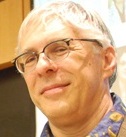2.7: Experimental studies on the origins of life
- Page ID
- 3911
One strategy to understanding how life might have arisen naturally involves experiments to generate plausible precursors of living systems in the laboratory. The experimental studies carried out by Stanley Miller (1930-2007) and Harold Urey (1893-1981) were an early and influential example of this approach.40 These two scientists made an educated, although now apparently incorrect, guess as to the composition of Earth's early atmosphere. They assumed the presence of oceans and lightning. They set up an apparatus to mimic these conditions and then passed electrical sparks through their experimental atmosphere. After days they found that a complex mix of compounds had formed; included in this mix were many of the amino acids found in modern organisms, as well as lots of other organic molecules. Similar experiments have been repeated with other combinations of compounds, more likely to represent the environment of early Earth, with similar results: various biologically important organic molecules accumulate rapidly.41 Quite complex organic molecules have been detected in interstellar dust clouds, and certain types of meteorites have been found to contain complex organic molecules. During the period of the heavy bombardment of Earth, between ~4.1 through ~3.9 billion years ago, meteorite impacts could have supplied substantial amounts of organic molecules.42 It therefore appears likely that early Earth was rich in organic molecules (which are, remember, carbon containing rather than life-derived molecules), the building blocks of life.
Given that the potential building blocks for life were present, the question becomes what set of conditions were necessary and what steps led to the formation of the first living systems? Assuming that these early systems were relatively simple compared to modern organisms (or the common ancestor of life for that matter), we hypothesize that the earliest proto-biotic systems were molecular communities of chemical reactions isolated in some way from the rest of the outside world. This isolation or selective boundary was necessary to keep the system from dissolving away (dissipating). One possible model is that such systems were originally tightly associated with the surface of specific minerals and that these mineral surfaces served as catalysts, speeding up important reactions; we will return to the role of catalysts in biological systems later on. Over time, these pre-living systems acquired more sophisticated boundary structures (membranes) and were able to exist free of the mineral surface, perhaps taking small pieces of the mineral with them.43
The generation of an isolated but open system, which we might call a protocell, was a critical step in the origin of life. Such an isolated system has important properties that are likely to have facilitated the further development of life. For example, because of the membrane boundary, changes that occur within one such structure will not be shared with neighboring systems. Rather, they accumulated in, and favor the survival of, one system over its neighbors. Such systems can also reproduce in a crude way by fragmentation. If changes within one such system improved its stability, its ability to accumulate resources, or its ability to survive and reproduce, that system, and its progeny, would be likely to become more common. As these changes accumulate and are passed from parent to offspring, the organisms will inevitably evolve, as we will see in detail in the next chapter.
Questions to answer & to ponder:
If we assume that spontaneous generation occurred in the distant past, why is it not occurring today? How could you tell if it were?
In 1961, Frank Drake, a radio astronomer, proposed an equation to estimate the number of technological civilizations that exist within the observable Universe (N).44 The equation is
\[N = R \times f_p \times n_e \times f_l \times f_i \times f_c \times L\]
where:
- R* = The rate of formation of stars suitable for the development of intelligent life.
- fo = The fraction of those stars with planetary systems.
- ne = The number planets, per solar system, with an environment suitable for life.
- fl = The fraction of suitable plants on which life actually appears.
- fi = The fraction of life-bearing planets on which intelligent life emerges.
- fc = The fraction of civilization that develop a technology that releases detectable signs of their existence into space.
- L = The length of time such civilizations release detectable signals into space. Identify those parts of the Drake equation that can be established (at present) empirically and that cannot, and explain your reasoning.

Contributors and Attributions
Michael W. Klymkowsky (University of Colorado Boulder) and Melanie M. Cooper (Michigan State University) with significant contributions by Emina Begovic & some editorial assistance of Rebecca Klymkowsky.


